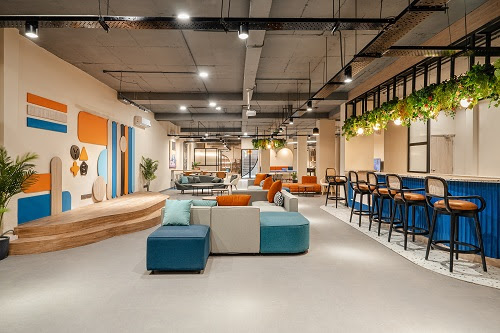E - PAPER
Bengaluru witnessed 8% CAGR in rental growth over last decade; NCR, MMR remained flat
IT-BPM sector has been the prime driver of the office demand in India over last decade. The employment in IT-BPM sector grew at rate of 6% CAGR over the last decade. The employment figure reached about 4.4 million in 2020 from about 3.0 million employment in 2011, which is an addition of 1 million s
 BY
Realty Plus
BY
Realty Plus
Published - Tuesday, 25 May, 2021

IT-BPM sector has been the prime driver of the office demand in India over last decade. The employment in IT-BPM sector grew at rate of 6% CAGR over the last decade. The employment figure reached about 4.4 million in 2020 from about 3.0 million employment in 2011, which is an addition of 1 million skilled white-collar jobs. The IT-BPM sector’s job growth remained steady even during the pandemic. “
The IT-BPM industry in India accounts for 55% of the total global outsourcing market. It accounts for more than 45% share in India, the largest in total services export. We expect the Indian IT & BPM industry to grow to US$ 350 billion by 2025 and BPM to account for US$ 50-55 billion out of the total revenue. India is the top off-shoring destination for IT companies across the world. Emerging technologies now offer an entire new gamut of opportunities for top IT firms in India, having both on-shore and off-shore services to global clients.,” said Arpit Mehrotra, Managing Director, Office Services, South India at Colliers.
Jobs in the IT-BPM sector are mostly concentrated in top 7 metros of the country. Bengaluru leads the pack of IT-BPM office spaces stock with about 162 million sq.ft. at the end of 2020, followed by Delhi NCR and Mumbai at 116 and 104 million sq.ft. respectively. In recent years, Hyderabad made rapid growth in IT-BPM job creation, where the annual gross absorption of commercial office space has been around 5 to 6million since 2016, although it did touch a high of over 9.5 million square feet in 2019.
As the employment in the IT-BPM sector grew, so did the overall commercial office stock. Across the top 7 cities the commercial office stock grew almost 1.8 times to reach half a billion square feet between 2010 to 2020. In the beginning of the previous decade, per capita IT space was about 124 sq.ft., which dropped to 115 sq.ft. per person by middle of the decade. The IT-BPM companies tried to pack more headcount in the existing space to accommodate short to medium term growth of the workforce.
Since 2015, there has been an increasing trend of campus style IT parks becoming operational across all metros. These campuses provided wholesome work environment with food, leisure, and recreation. As a result, the per capita space started to increase gradually and reached about 123 sq.ft. per person by 2020. Of course, COVID-19 had a significant impact on the per capita space since last year.
Despite the robust growth of technology sectors and steady increase in headcount, the rentals of the commercial offices did not grow much. At a pan India pan India level, the CAGR of rental growth for the previous decade has been merely 2%, which is lower than even the inflation rate. At a city level, Bengaluru witnessed about 8% CAGR in rental growth, while the NCR and the MMR remained almost flat over the last decade. Rest of the metros had a modest 3% to 4% CAGR in rental growth.
For IT-BPM companies, the real estate cost per employee was about INR 98 thousand per year, which grew to INR 1.17 lakh by 2020. For IT-BPM companies, the biggest cost head is the salary of the employees. According to the filing at the stock market, TCS, Infosys, Wipro all have paid more than 50% of their top line as salary. On the contrary, the real estate costs for the IT -BPM companies are only about 8-10 %. Just to put it in perspective, top banking companies like SBI, HDFC and ICICI spends about 10 to 17% of their top line as employee cost.
“In the coming days, cost optimization will be one of the key focuses for the IT, BPO companies. Since the companies have mainstreamed the decentralization of work during the pandemic, they will now be more open to exploring markets where human resources and real estate costs are low. As we advance, IT BPO companies could try to optimize their business, keeping the cost in mind as well as a hedging strategy against any future disruptions, with a hub and spoke model that might include flexible spaces, multi-city locations, and home offices,” said, Subhankar Mitra, Managing Director, Advisory Services (India), Colliers.
The current pandemic situation has provided great uncertainty about how the commercial office absorption for IT-BPM sector is likely to be in the 2021. At the moment, the sector has adopted ‘work from home’ policy. Going forward a ’hybrid work from home and office model’ is expected to be followed by the leading IT-BPM players, where part of the workforce will operate from the existing office spaces, maintaining social distancing, some will continue to work from home on a rotation basis and the remaining workforce and future employment will operate from new offices and/or from “flexible work spaces’. Since the salary cost of their employee is going remain the dominant cost for the companies, they would try and improve their profitability by optimizing on their real estate spaces.
RELATED STORY VIEW MORE
NEWS LETTER
Subscribe for our news letter
E - PAPER
-

CURRENT MONTH 
LAST MONTH














